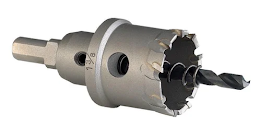Guide to Hole Saw Cutters
Hole Saws are simply metal or plastic discs with teeth or small blades protruding from the perimeter of their circumference. The purpose of these metal discs is to drill a hole in the material. They can be used in a variety of different ways and materials, but they are most commonly used in woodworking, especially when creating holes for handles or knobs. Regardless of their size or material type, Hole Saws will always have the same purpose—to create holes in material—and they can be used on multiple different materials from metal to plastics to wood.
What is a hole saw cutter?
A hole saw is a round blade attachment used to drill big holes in wood. It's a must-have for people who are into woodworking and building things because it makes your life a lot easier by drilling a nice, clean hole in the center of the material. If you've ever had to use a drill bit that isn't shaped like a circle, you know how hard it is to get those corners right. The problem with those other kinds of bits is that they have limited space for the drill chuck to grip onto, so they can easily slip around and mess up your cut. With their wider grip space, hole saws don't have this problem—so they're much more reliable than other kinds of bits.
Uses of hole saw cutters:
Hole saws are an essential tool for any tradesman or DIYer who is working with pipes and tubing. They're also a great choice for home improvement projects such as installing a new sink, shower head, faucet, or water line. There are several types of hole saws on the market today, and each one has a specific purpose. Your choice will depend on your budget and the type of materials you'll be cutting through.
The hole saw's design is simple enough: a circular blade is attached to a handle that can twist to cut evenly through different materials. The size of the blade will determine what you can use it for, so choosing the right one is key. A smaller blade will be best if you need to make intricate cuts through metal or plastic tubing. For example, if you're installing a tap under your kitchen sink, or rerouting pipes in your bathroom. A small blade will allow you to make multiple holes without damaging large portions of metal surfaces. On the other hand, if you're cutting wood or tile, you'll want a larger hole saw that can quickly drill out big chunks at once, rather than slow down with lots of tiny holes.
Different types of hole saw cutters:
HSS-G (Ground) Hole Saws:
The HSS-G (Ground) Hole Saw is the most common type of hole saw, and it's used for cutting holes into flat surfaces. However, there are specialty hole saws that can cut holes into vaulted or spiral surfaces, too.
As with most products in the Hole Saw family, this item has a wide range of material applications. It cuts steel up to 800 N/mm2 and cast steel up to 2.5 mm, as well as non-ferrous and light metals up to 2.5 mm. It can cut through plastic, reinforced fabrics, plasterboard, and lightweight boards up to 5.0 mm thick.
It's also worth noting that this product is not considered ideal for heavy-duty construction building projects of industrial strength like those you might see on a bridge or tunnel construction site. This is because the tool's HSS-G Steel material is lightweight and not meant for heavy-duty use; it's best for everyday lightweight home improvement tasks like cutting holes in walls or floors for pipes or cables.
Tungsten Carbide Hole Saws:
Tungsten carbide hole saws are an excellent choice for both industrial and commercial applications, as well as home improvements. Each type of tungsten carbide hole saw has a different purpose and is designed to cut through different materials and thicknesses.
Tungsten carbide hole saws come in three main types:
shallow-cut tungsten carbide hole saws,
multigrade tungsten carbide hole saws,
and thin-wall tungsten carbide hole saws.
Each of these three types of tungsten carbide hole saws is used for cutting through very different materials with very different results. Shallow Cut TC Hole Saws have a cutting depth of up to 2mm into steel or 4mm into plastic, while Multigrade TC Hole Saws can handle up to 20mm into steel and 28mm into plastic. Thin-wall TC Hole Saws are designed to cut through thin-walled metals (up to 0.6mm thick) with precision and efficiency.
Multi-Hole Saw:
Multi-hole saws are a delight to use for many reasons. They're simple in design and can be used with a variety of materials, which is great for the crafter. Their sharp edges allow for cutting holes through the material with high precision, reducing the chances of damaging or breaking the material. Many multi-hole saws are also compatible with power drills, making them versatile and easy to use, even for those who don't have much experience wielding power tools. However, one thing that should be noted is that these saws come in different sizes, so check to be sure that your multi-hole saw will work with your drill bit size before you buy it.
In the end: There's a lot to know about hole saw cutters. It's important to understand what different styles are available and how they can affect the depth and diameter of your cuts. It's also critical to know what kind of materials you'll be cutting and whether or not you need to match your cutter to the material. Saleh Ishaq Trading Co. L.L.C has all of the information that you need for making informed decisions about all of these things, as well as a wide selection of cutters that are ideal for different materials.



.jpg)
Comments
Post a Comment